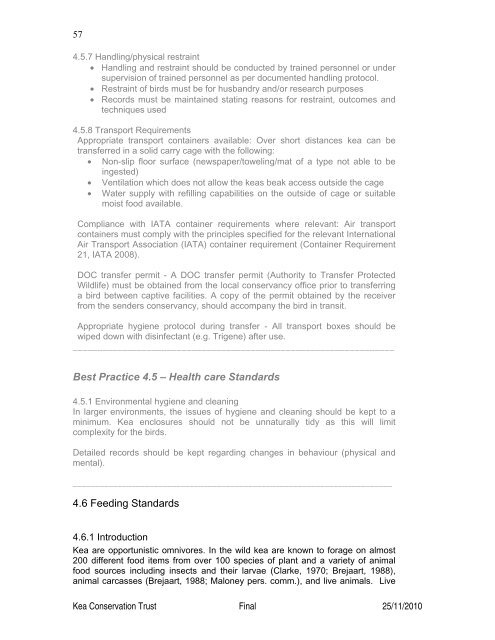(Nestor notabilis) Husbandry Manual - Kea Conservation Trust
(Nestor notabilis) Husbandry Manual - Kea Conservation Trust
(Nestor notabilis) Husbandry Manual - Kea Conservation Trust
You also want an ePaper? Increase the reach of your titles
YUMPU automatically turns print PDFs into web optimized ePapers that Google loves.
57<br />
4.5.7 Handling/physical restraint<br />
• Handling and restraint should be conducted by trained personnel or under<br />
supervision of trained personnel as per documented handling protocol.<br />
• Restraint of birds must be for husbandry and/or research purposes<br />
• Records must be maintained stating reasons for restraint, outcomes and<br />
techniques used<br />
4.5.8 Transport Requirements<br />
Appropriate transport containers available: Over short distances kea can be<br />
transferred in a solid carry cage with the following:<br />
• Non-slip floor surface (newspaper/toweling/mat of a type not able to be<br />
ingested)<br />
• Ventilation which does not allow the keas beak access outside the cage<br />
• Water supply with refilling capabilities on the outside of cage or suitable<br />
moist food available.<br />
Compliance with IATA container requirements where relevant: Air transport<br />
containers must comply with the principles specified for the relevant International<br />
Air Transport Association (IATA) container requirement (Container Requirement<br />
21, IATA 2008).<br />
DOC transfer permit - A DOC transfer permit (Authority to Transfer Protected<br />
Wildlife) must be obtained from the local conservancy office prior to transferring<br />
a bird between captive facilities. A copy of the permit obtained by the receiver<br />
from the senders conservancy, should accompany the bird in transit.<br />
Appropriate hygiene protocol during transfer - All transport boxes should be<br />
wiped down with disinfectant (e.g. Trigene) after use.<br />
_________________________________________________________________<br />
Best Practice 4.5 – Health care Standards<br />
4.5.1 Environmental hygiene and cleaning<br />
In larger environments, the issues of hygiene and cleaning should be kept to a<br />
minimum. <strong>Kea</strong> enclosures should not be unnaturally tidy as this will limit<br />
complexity for the birds.<br />
Detailed records should be kept regarding changes in behaviour (physical and<br />
mental).<br />
_______________________________________________________________________<br />
4.6 Feeding Standards<br />
4.6.1 Introduction<br />
<strong>Kea</strong> are opportunistic omnivores. In the wild kea are known to forage on almost<br />
200 different food items from over 100 species of plant and a variety of animal<br />
food sources including insects and their larvae (Clarke, 1970; Brejaart, 1988),<br />
animal carcasses (Brejaart, 1988; Maloney pers. comm.), and live animals. Live<br />
<strong>Kea</strong> <strong>Conservation</strong> <strong>Trust</strong> Final 25/11/2010












